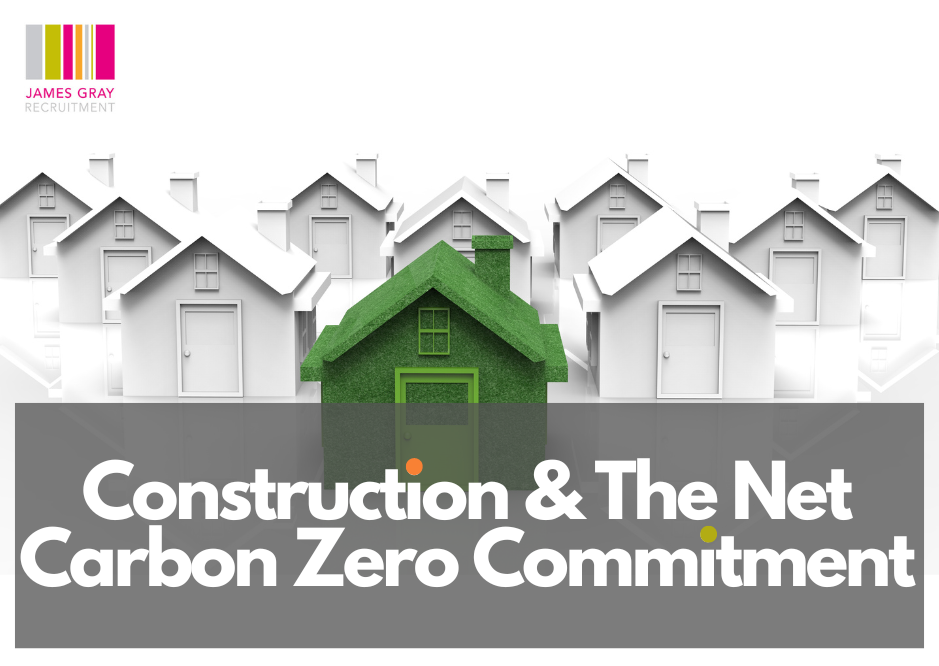
Construction & The Net Carbon Zero Commitment
In 2019, the UK Government and the devolved administrations became the first major economy in the world to pass laws to end its contribution to global warming. This legally binding target requires the UK to bring all greenhouse gas emissions to net zero by 2050.
With approximately 43% of the UK's carbon emissions attributable to the built environment, the construction industry has a huge burden of responsibility when it comes to driving down emissions, so what is the sector doing to ensure they fulfil their share of the Net Zero commitment?
In direct response to the government’s commitment The Construction Leadership Council (CLC) recently launched its CO2nstruct Zero initiative, A new cross-industry programme that aims to drive carbon emissions out of all parts of the construction sector, from manufacturing and design to build and operation.
The 9 priorities tackled by the programme are:
Transport
- Accelerating the shift of the construction workforce to zero emission vehicles and onsite plant
- Maximising use of modern methods of construction and improved onsite logistics, reducing waste and transport to sites
- Championing developments and infrastructure investments that both enable connectivity with low carbon modes of transport and are designed to incorporate readiness for zero emission vehicles
Buildings
- Work with government to deliver retrofitting to improve energy efficiency of the existing housing stock
- Scale up industry capability to deliver low carbon heat solutions in buildings, supporting heat pump deployment, trials of hydrogen heating systems and heat networks
- Enhancing the energy performance of new and existing buildings through higher operational energy efficiency standards and better building energy performance monitoring
Construction Activity
- Implementing carbon measurement, to support construction projects in making quantifiable decisions to remove carbon
- Become world leaders in designing out carbon, developing the capability of designers and construction professionals to develop designs in line with a circular economy – reducing embedded and operational carbon, shifting commercial models to incentivise and reward measurable carbon reductions.
- Support development of innovative low carbon materials (prioritising concrete and steel), as well as advancing low carbon solutions for manufacturing production processes and distribution.
What support is the government offering?
In July 2020 the government announced an £800 million package of measures to help the UK reach this target, including investment in green jobs, green technology and green infrastructure. In the same month they also introduced new policies to reduce emissions, such as the Green Homes Grant and the Green Transport Strategy.
In addition, the following initiatives and guidance have been put in place: -
- The Green Construction Board (GCB) was set up to provide guidance and advice to the construction sector on how to reduce emissions and build more sustainably.
- The Construction Playbook, launched in 2020, provides guidance on how to deliver low-carbon construction projects.
- The Building Safety Fund, launched in 2021, provides funding for the installation of measures to make buildings safer and more energy-efficient.
- The government has also provided funding for research and development in the construction sector, such as for the development of new low carbon materials and techniques, as well as for the retrofitting of existing buildings.
Andy Mitchell chairman of CLC said:
We’ve seen the transformative impact that collective ambition has had on our industry’s standing with Government during Covid, who are now clear that the construction industry must be a key partner in the drive to reach UK Net Zero by 2050.
We must now bring the same spirit and energy to addressing the climate emergency.
By providing a consolidated action plan, clear targets and a single ambitious vision for change we hope that we can bring together the excellent work being done across the industry in a coordinated way to drive real transformation.”
The CLC has now invited companies big and small from across the industry to work together with CO2nstruct Zero, to help with its delivery and ensure its success.
It added that CO2nstruct Zero’s purpose is not to develop new solutions or new pathways but to bring people together to consolidate collective actions and plans for the sector.
An action plan aligned to the nine priorities is being prepared, co-ordinating the work already happening across the industry (including within the CLC through the Green Construction Board and the Infrastructure Client Group) to develop the solutions and guiding companies on the actions and role that they can play.
The action plan will also consider changing skills needs and how these can be addressed to provide a workforce that can achieve net zero.
The built environment represents some of the most cost-effective opportunities to decarbonise. Energy use in homes alone generates 14% of our emissions. A national retrofit programme would be a financially savvy way of slashing emissions, whilst providing co-benefits including high-quality jobs and lower energy bills for communities in every corner of the UK.
But beyond any one type of building, whether its new or existing, we need to embed net-zero thinking across the entire built environment value chain. From client to contractor, product manufacturer to specifier: everyone needs to have net-zero squarely in their sights.
Searching for an opportunity in the construction industry? Or are you a hiring manager in search of the top talent in the market today? Contact James Gray’s Recruitment’s team of industry experts to start the conversation. getus@jamesgrayrecruitment.com

